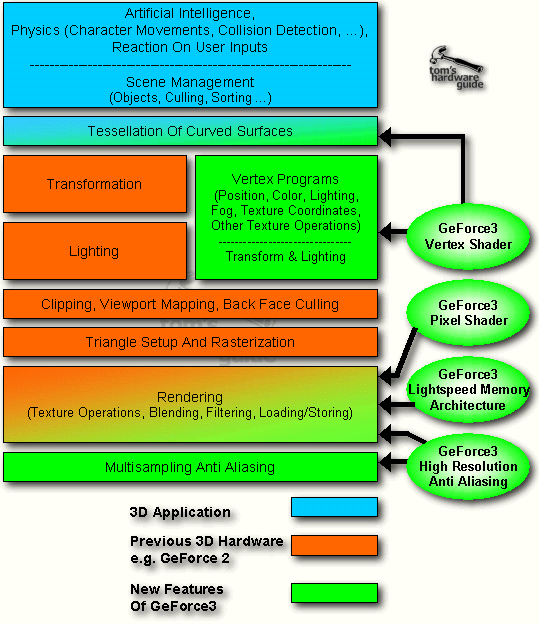High-Tech And Vertex Juggling - NVIDIA's New GeForce3 GPU
The General Features Of GeForce3
NVIDIA's latest chip comes up with several impressive numbers:
- Process: .15u
- Transistors: 57M
- Pixel Pipelines: 4
- Simultaneous Textures Per Pixel: 2
- Maximum Active Textures Per Pixel per Pass: 4
- Number of Pixel Shading Operations per Pass: 36 (4 per combiner, 9 combiners)
- Vertex Instructions Per Vertex per Pass: 128
- Core Frequency Of Released Card: 200 MHz
- Memory Frequency Of Released Card: 230 MHz DDR
- Frame Buffer Of Released Card: 64 MB
- Supported Memory: SDR or DDR
- Memory Interface Width: 128 bit
GeForce3 has no less than 57 million transistors, which is more than double the amount of transistors found on GeForce2 chips. Even Intel's latest processor, the Pentium 4, comes with over 20% less transistors. To avoid that this huge amount of gates requires a very large silicon die, GeForce3 is manufactured in 0.15 micron process. This further shrink down from the previous 0.18 micron process of the GeForce2 line of chips is also required to enable high clock rates and low power consumption of NVIDIA's new monster chip.
On the first look some other numbers make it seem as if GeForce3 shares quite a few hardware features with its predecessor GeForce2. There are still four pixel pipelines and two simultaneous textures that can be applied to a pixel. The memory interface is still 128 bit wide and clocked at 230 MHz (460 MHz DDR), which seems to make it identical to GeForce2 Ultra. The core clock of GeForce3 is with 200 MHz even lower than the 250 MHz found on GeForce2 Ultra cards.
As you read on you will learn however, that the 57 million transistors of GeForce3 were certainly not wasted. Even though GeForce3 might have several general spec numbers that sound as if NVIDIA's new chip is only little advanced over the GeForce2 line of 3D-chips, you will find that almost each feature of GeForce2 was significantly advanced, making GeForce3 a chip with several excellent technologies that even put GeForce2 Ultra cards to shame. Let's go through those advances one by one.
According to my old tradition, I will discuss those new technologies in the succession as they influence the 3D-pipeline. The below graph should give you a basic overview:
Get Tom's Hardware's best news and in-depth reviews, straight to your inbox.
Current page: The General Features Of GeForce3
Prev Page Introduction Next Page GeForce3's New Vertex Shader - A Poor Name For A Great Set Of Features
